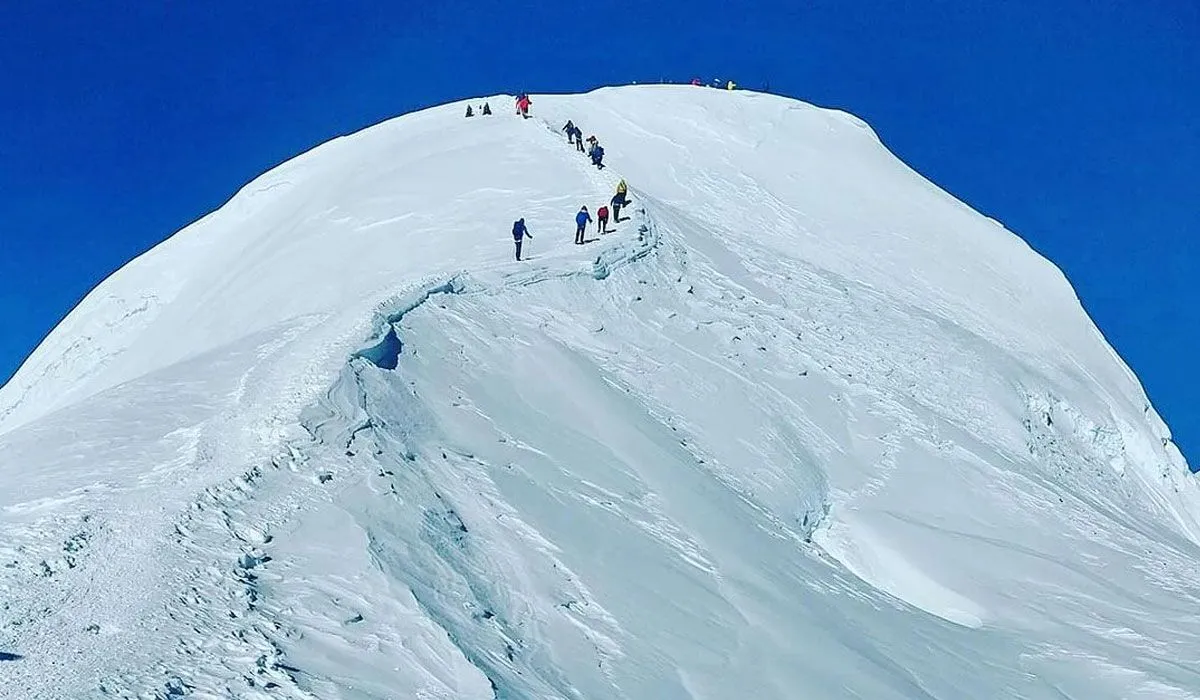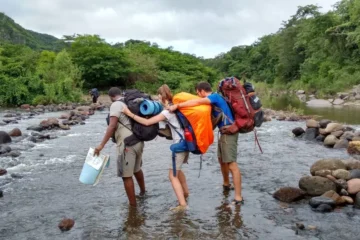One of the most well-liked trekking summits in the Khumbu region is Mera Peak. At 6,476 meters, or 21,247 feet, above sea level, it is the highest trekking peak in the Himalayas. For travelers from all over the world, Mera Peak has been providing an exciting mountaineering experience. Since the majority of inexperienced climbers first summit this peak before trying the eight-thousander Mountains, it is a popular choice among them. Mera Peak is a doable excursion throughout the amazing mountainous terrains, although being rather tough. Thus, don’t be afraid to overcome its obstacles and scale the heights of Mera Peak.
In the Himalayas, Mera Peak is one of the most popular choices for thrill-seeking explorers. Trekking across the many Himalayan environments, including verdant forests, charming Sherpa settlements, alpine meadows, and glacier terrain, is required to reach the summit of Mera Peak. Five of the highest peaks in the world, including Everest, Kanchenjunga, Makalu, Lhotse, and Cho Oyu, are visible from the summit of Mera Peak. But the question that lingers in the minds of all expeditors is this: is Mera Peak dangerous?
Mera Peak is renowned for having a peak that is safe. As a warm-up mountain for climbers gearing up to take on more difficult Himalayan peaks, Mera Peak is not an especially difficult mountain to ascend. That being said, there could be certain challenges, which would make the Mera Peak ascent challenging at times. The Mera Peak adventure is not technically difficult, but it is physically taxing due to the altitude. Climbing Mera Peak is an exciting experience that no climber, experienced or novice, should pass up.
Mera Peak Grade
Mera Peak is classified as challenging enough to be in the Alpine Grade PD category. This indicates that there may be some technical climbing and challenging glacier crossings to reach the summit Mera Peak was previously categorized as Alpine Grade F, meaning that climbing it was simple or easy.
The change in difficulty classification from Grade F to PD is indicative of either revised route conditions or a better comprehension of the climbing problems. The final portion of a difficult, steep climb and the involvement of glaciated moraines are also responsible for the grade shift.
Is Mera Peak Technical?
Mera Peak climbing is regarded as non-technical. But you must possess some fundamental mountaineering abilities. As you get closer to higher elevations, the terrain will get increasingly difficult and rocky. Steep hills and patches of ice must be navigated on the last few steps leading to the top of Mera. Crampons, ice axes, and ropes—basic climbing gear—are needed to negotiate these sections.
The problems faced by climbers include setting up a high camp and navigating the glaciated pathways. The glacier crossing is one of the more difficult parts of the Mera Peak ascent. There are crevasses in the Mera Glacier that you must traverse. The path across it may constantly alter as a result of glacier movement and ice melting. Thus, you need use caution when locating paths and be familiar with glacier navigation methods. For safe and efficient navigation, you must be knowledgeable of avalanche awareness, rope management techniques, and crevasses rescue techniques.
Despite not being overly technical, Mera Peak has difficulties that call for careful planning and preparation. Additionally, a high level of physical fitness combined with efficient acclimatization techniques is crucial for the Mera Peak success rate.
Is Experience Required to Climb Mera Peak?
Prior high-altitude trekking and mountaineering experience is helpful but not required for climbing Mera Peak. For climbers who possess basic climbing skills and modest experience in alpine terrain, Mera Peak is the ideal excursion. Experience will undoubtedly improve safety and raise the possibility of a successful summit effort. Furthermore, if you have a solid altitude acclimatization plan, fundamental technical proficiency, and excellent physical fitness, the climb is incredibly gratifying.
It is always beneficial for safe climbing to have knowledge of mountainous risks such as crevasses, avalanches, altitude sickness, etc., as well as familiarity with the weather and temperature of the alpine environment. Climbers who have been on high-altitude expeditions before are usually able to identify the signs of altitude sickness early on and take the necessary precautions to reduce the dangers. You can make the proper choices in difficult situations if you have a solid foundation of mountaineering skills.
While climbing Mera Peak does not strictly require experience, you can assess your level of skill, expertise, and preparedness prior to taking on the challenges. To guarantee a risk-free, entertaining, and fulfilling climb of Mera Peak, think about obtaining advice or instruction. If you have never been on an adventure before, you can try to get some altitude experience by going on quick climbs to become accustomed to changing altitudes before you climb Mera Peak.
How difficult is Mera Peak Climbing?
Mera Peak is regarded as the gateway mountain for Himalayan adventures and high-altitude trekking. It is well known because amateur climbers use it as a practice peak. Mera Peak acts as a training ground for climbers, getting them ready for the more difficult adventure. Thus, climbers frequently use the Mera Peak trek as a training run before taking on other challenging summits. Future expedition experiences will benefit from the experience, knowledge, abilities, and self-assurance obtained by the climb of Mera Peak.
There aren’t any extremely difficult climbs on the way to the summit. But reaching the thin air of the Himalayas is a bit difficult for climbers due to Mera Peak’s elevation of 6,476 meters. The route has some tough aspects, but the majority of the ascent is easy. Crampons and an ice axe are necessary for traversing the glacier, which is a part of the ascent. The final part of the climb, close to the summit ridge, requires navigating steep slippery terrain and a snow dome. This section can be completed by using an ascender on a fixed rope. Therefore, because of its great height and some tricky paths, the Mera Peak climb is regarded as fairly tough.
While there are some difficult sections on the mountain, these are ideal challenges for novice climbers to develop their expedition abilities. Therefore, Mera Peak is reachable with a reasonable level of mountaineering experience, peak climbing expertise, suitable equipment, acclimatization, and a physically fit physique.
Difficulties Related to Mera Peak
Physically Demanding
While the summit is easy to reach technically, the combined trekking and climbing route can be strenuous on the body. To gain the strength and stamina needed for the expedition, you can engage in physical training. To combat the trek/climb obstacles, try some modest fitness workouts and regular cardiovascular conditioning. Think about doing push-ups, squats, deadlifts, sprinting, dancing, brisk walking, swimming, step-ups, and planks. Your enhanced strength gets you ready for the thrilling trek and ascent of Mera Peak.
Unpredictable Weather
Weather has an impact on the safety of climbing Mera Peak as well. It’s common knowledge that the environment and temperature fluctuate at high elevations are unpredictable. Changes in the weather could make summit climbing even more challenging. The difficulties of the excursion are increased by factors including strong winds, heavy rain, snowfall, and colder temperatures. The weather determines climbing success, difficulty, and safety, particularly during the summit push. Thus, you should keep a constant eye on the weather report and only try to reach the top when the weather is suitable. If you want to protect yourself from unfavorable weather, you can wait or even withdraw.
Temperature Fluctuations
When trying to go mountaineering at high altitudes, temperature is an important consideration. Higher altitudes have significant temperature variations, which complicate peak expeditions. Although lower region paths endure generally moderate weather, alpine elevations can be very chilly. As a result, you must pack appropriately for the temperature and altitude changes. It is best to bring clothing appropriate for the many climate zones found in the alpine area. Peak climbing seasons are in the spring and fall, when you can expect steady weather, comfortable temperatures, clear skies, and breathtaking vistas of the Himalayas.
Altitude Sickness
One of the biggest concerns for climbers trying to reach Mera Peak is altitude sickness. Mera Peak’s high altitude can cause minor discomfort or even serious bouts of altitude sickness. It is important to pay attention to general symptoms such as nausea, vomiting, headaches, dizziness, insomnia, and appetite loss. Thus, pay close attention to any potential symptoms and quickly lower yourself to a lower altitude if things get worse.
The best ways to avoid altitude sickness are to acclimate properly, stay hydrated, and move slowly. With each height climb, the air gets thinner. Nonetheless, a gradual ascent that provides ample time for acclimatization aids in the body’s adaptation to the lowering oxygen concentration. As a result, you can easily adjust to the increasing altitude.
Is It Safe to Climb Mera Peak?
Mera If peak climbing is done with careful planning, comprehensive preparation, and adherence to safety regulations, it’s a safe and rewarding activity. There is always some risk involved with mountain climbing. Nonetheless, peak climbing carries some possible risks that can be mitigated with the right measures. Prioritizing knowledge of the route, potential difficulties, and high-altitude weather patterns is essential. Getting a local guide with experience or going on an expedition with one also contributes to increased safety. You can climb safely and joyfully if you have access to excellent support and experience.
How to Approach Mera Peak?
For a secure and fruitful Mera climb, adopt a methodical and planned strategy. At 5,800 meters above sea level, Mera High Camp is a place you should not go straight. Think of staying overnight at 5,415-meter Mera La in between. From Khare to Mera High Camp, there is a total height rise of about 850 meters. Dealing with this substantial elevation gain is challenging. Making the tactical choice to spend the night at Mera La helps you avoid altitude sickness. In due course, it also increases the chance of a successful ascent of Mera Peak.
Rest Stops
Make rest and recuperation a priority during your climb Mera Peak. Plan frequent pauses to replenish fluids and allow the body to heal. During your leisure days at Base Camp and High Camps, unwind, get used to the altitude, and take in the breathtaking Himalayan landscape. Maintaining energy levels, preventing weariness and injuries throughout the climb, and getting enough sleep and recovery are all crucial. Don’t take needless detours and always stay on designated pathways. Remember to carry emergency supplies and necessary safety equipment in case of unanticipated events. It is advised to bring food, water, radio communication equipment, a first aid kit, and other supplies in case of injury or delay.
Early Start
Plan your summit bid based on the weather forecast, route conditions analysis, and physical and mental preparedness. The ideal time to try the Mera Peak summit is early in the morning. Clear skies, pleasant temperatures, steady snow or ice, calm winds, and stable weather are all present at dawn. Aim to start the summit push prior to sunrise in order to give yourself enough time to complete the Mera peak top climb. Visibility is hampered by bad weather and a strong, gusty wind as afternoon approaches. It is more difficult to navigate across the glacier during descent in such conditions. Therefore, make a safe descent back before unfavorable weather conditions arise.



